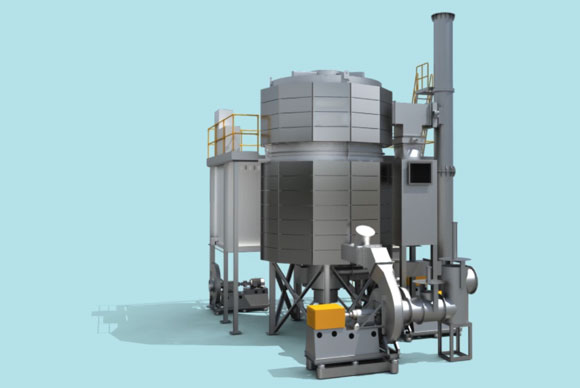Regenerative Thermal Oxidizer Temperature
Regenerative Thermal Oxidizer (RTO) is a pollution control technology used to remove volatile organic compounds (VOCs) and hazardous air pollutants (HAPs) from industrial exhaust streams. The RTO operates at high temperatures to break down and oxidize the pollutants. Temperature plays a critical role in the design and performance of RTOs.
Factors Affecting RTO Temperature
Waste Stream Composition
The composition of the waste stream affects the temperature of the RTO. Different VOCs and HAPs have different combustion temperatures, and the RTO must be designed to reach the required temperature for complete combustion. The fuel value of the waste stream also affects the RTO temperature. A higher fuel value waste stream will require less supplemental fuel to maintain the required temperature.
Flow Rate
The flow rate of the waste stream affects the temperature of the RTO. A higher flow rate will require more energy to heat the waste stream to the required temperature. The residence time of the waste stream in the RTO also affects the temperature. A longer residence time allows more time for heat transfer and combustion, resulting in a higher RTO temperature.
Air Supply
The air supply to the RTO affects the temperature. The RTO requires a sufficient amount of oxygen to support combustion and maintain the required temperature. Insufficient air supply will result in incomplete combustion and a lower RTO temperature.
Heat Recovery
The heat recovery system used in the RTO affects the temperature. The RTO can recover heat from the exhaust stream to preheat the incoming waste stream, reducing the amount of energy required to maintain the required temperature. A more efficient heat recovery system will result in a higher RTO temperature.
Operating Conditions
The operating conditions of the RTO affect the temperature. The RTO must be operated within the designed temperature range to ensure complete combustion and prevent equipment damage. Changes in the operating conditions, such as changes in the waste stream composition or flow rate, can affect the RTO temperature.

RTO Temperature Monitoring
The temperature of the RTO must be monitored to ensure proper operation. Thermocouples are commonly used to measure the temperature at various points in the RTO. The temperature data can be used to adjust the air supply and fuel supply to maintain the required temperature and optimize the energy efficiency of the RTO.
RTO Temperature Control
The temperature of the RTO can be controlled by adjusting the air supply and fuel supply. The air supply can be adjusted to increase or decrease the oxygen available for combustion. The fuel supply can be adjusted to increase or decrease the amount of energy introduced to the RTO. A control system can be used to automatically adjust the air supply and fuel supply to maintain the required temperature and optimize the energy efficiency of the RTO.
RTO Temperature Safety
The high temperatures in the RTO pose a safety hazard. The RTO must be designed and operated to prevent equipment damage and minimize the risk of fire or explosion. Safety features, such as temperature alarms and pressure relief valves, must be included in the RTO design to protect personnel and equipment.
Company Introduction
We are a high-end equipment manufacturing enterprise specializing in the comprehensive treatment of volatile organic compounds (VOCs) and carbon reduction and energy-saving technologies. Our core technologies include thermal energy, combustion, sealing, and automatic control. We have the capabilities for temperature field simulation, air flow field simulation modeling, ceramic heat storage material performance, molecular sieve adsorption material selection, and VOCs high-temperature incineration and oxidation experimental testing.
Team Advantages
We have an RTO technology research and development center and waste gas carbon reduction engineering technology center in Xi’an, as well as a 30,000 square meter production base in Yangling. We are a leading manufacturer of RTO equipment and molecular sieve rotary equipment. Our core technical team comes from the Aerospace Liquid Rocket Engine Research Institute (Aerospace Sixth Institute). We have over 360 employees, including more than 60 R&D technology backbones, among which there are 3 senior engineers at the research level, 6 senior engineers, and 16 thermodynamics PhDs.
Core Products
Our core products include the rotating valve regenerative thermal oxidizer (RTO) and molecular sieve adsorption concentrator. Combined with our expertise in environmental protection and thermal energy system engineering, we can provide customers with comprehensive solutions for industrial waste gas treatment, carbon reduction, and thermal energy utilization under various working conditions.

Here are the certifications, qualifications, patents, and honors we have obtained:
- Intellectual Property Management System Certification
- Quality Management System Certification
- Environmental Management System Certification
- Construction Industry Enterprise Qualification
- High-tech Enterprise
- Patent for Rotating Valve Regenerative Thermal Oxidizer
- Patent for Rotary Heat Storage Incineration Equipment
- Patent for Disc Zeolite Rotary Wheel

Choosing the Right RTO Equipment
- Consider the specific treatment requirements: The selection of RTO equipment should be based on the characteristics of the waste gas and the required treatment efficiency.
- Evaluate the operating cost: It is important to consider factors such as energy consumption, maintenance requirements, and auxiliary equipment costs.
- Assess the space and layout: The available space for installation and the layout of the equipment should be taken into account to ensure proper functioning and ease of maintenance.
- Examine the control system: The control system should be user-friendly, reliable, and capable of monitoring and optimizing the operation of the RTO equipment.
Service Process
- Consultation and Evaluation: Initial consultation, on-site inspection, and needs analysis.
- Design and Solution Development: Designing the appropriate solution through simulation and evaluation.
- Production and Manufacturing: Customized production with strict quality control and factory testing.
- Installation and Commissioning: On-site installation, commissioning, and training services.
- After-sales Support: Regular maintenance, technical support, and spare parts supply.
We offer a one-stop solution with a professional team that tailors RTO solutions to meet each customer’s needs.
Author: Miya
